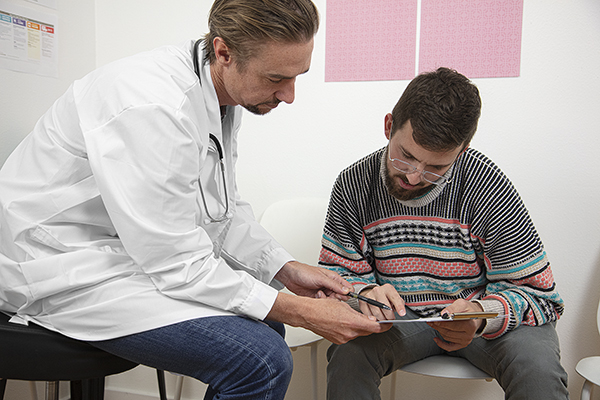The effects of aging in males are felt in various ways. Everything from grey hair, an aching back, and less of a pep in your step from what you remember in younger years are all indicators of growing older. Another tell-tale sign along the natural course of advanced aging is late onset hypogonadism - one of the most common symptoms of male menopause. Male hypogonadism can start during fetal development, may occur during puberty, or be detected in adulthood. Late onset hypogonadism, a type of androgen deficiency, is an age-related form of secondary hypogonadism. This condition is generally defined as a deficiency in testosterone in aging men when compared to the levels of younger, healthy men. However, there are three key factors responsible for this testosterone deficiency, specifically for late onset hypogonadism: aging process, acute illness, and/or drug interference. First, starting at age 30, a man’s total testosterone levels begin to decline at an average of one percent every year. This often results in symptoms such as erectile dysfunction and low sex drive, among others, with a late onset hypogonadism diagnosis. Keep in mind, though, there are instances when male hypogonadism symptoms may be related to other health conditions, and not all hypogonadal men experience the same side effects. Since a low testosterone level is usually detected through a blood test, it’s important for men to be aware of changes in the body as they age and what kind of symptoms to look out for to maintain good health. Changes to a male’s physical, mental, and/or sexual health can also be indicative of adverse effects for other normal body functioning and cause a disruption in their quality of life. Second, an acute illness, such as gallbladder surgery, head trauma, or stroke can lead to low testosterone levels. These decreased testosterone levels may last a few days, several weeks, or indefinitely. When experiencing any of these types of illnesses or injuries to the body, it’s best to proceed with caution when interpreting results of any late onset hypogonadism testing during this time. There may be fluctuating results indicative of an androgen deficiency that subside once healing is complete. Third, opioid drugs commonly prescribed to treat chronic pain, including tramadol and methadone, may suppress testosterone production. Other medications that treat depression and anxiety may also have an effect on testosterone deficiency or low testosterone in men. When an aging male meets the criteria for any of these three primary factors, a change in their total testosterone level is likely to occur and symptoms of male menopause may begin to manifest.
Symptoms of Late Onset Hypogonadism
As with other medical conditions, physical or sexual symptoms call attention to assess changes in the body and seek testing and treatment as necessary. Common hypogonadism symptoms include:
- Erectile dysfunction or other sexual dysfunction
- Low sex drive and activity
- Hot flashes or sweats
- Breast swelling or discomfort
- Decreased energy levels
- Reduced muscle mass
Late onset hypogonadism may also affect a person’s confidence levels, lead to sleep disruptions, anxiety, and/or depression. There’s also a higher prevalence of cardiovascular disease, osteoporosis, anemia, and type 2 diabetes in men who experience a low testosterone level. Although, there are instances of men who have late onset hypogonadism but do not present clinical symptoms. However, if you’re experiencing any of these symptoms and are over the age of 40, it’s a good idea to get tested and see what testosterone treatment options are available to you. Testing can rule out other hormone or gland disorders that may be affecting your health. Since symptoms of late onset hypogonadism affect you across all levels of health, the benefits of natural testosterone treatment can improve your overall quality of life.
Treatment Options for Late Onset Hypogonadism
To treat clinical symptoms, a physician may recommend testosterone replacement therapy, which may include medical testosterone supplementation or injection. Risks are involved, especially for aging men who are otherwise healthy. Side effects of testosterone shots include increased sleep apnea, limited sperm production, and too much production of red blood cells, which can lead to blood clot formation. Plus, the effectiveness of testosterone therapy varies among hypogonadal men and can become costly overtime to maintain the necessary doctor visits and prescriptions. So, what about how to increase testosterone naturally? As an alternative to the testosterone therapy route, ED devices, like the Eddie by Giddy, has proven effective at helping to maintain an erection without the need for a prescription. Plus, it’s comfortable to wear as compared to pumps or rings that can cause pain and bruising. When this solution is implemented along with natural ways to boost testosterone production, such as exercise and good heart health, it improves the aging process. There’s no way to reverse the signs and symptoms of aging, but there are ways to feel better as you get older. With the number of health conditions, including social and psychological problems associated with late onset hypogonadism, it’s a good idea to be both preventative and proactive about your health. Get plenty of rest, follow a balanced diet, exercise on a daily basis, and check out safe ED products. These habits all support preventing cardiovascular disease, negative sexual symptoms, as well as improve your mental well-being. Sources:
- https://www.ncbi.nlm.nih.gov/pmc/articles/PMC5509975
- https://www.mayoclinic.org/diseases-conditions/male-hypogonadism/symptoms-causes/syc-20354881
- https://www.mayoclinic.org/healthy-lifestyle/mens-health/in-depth/male-menopause/art-20048056
- https://www.healthline.com/health/low-testosterone/warning-signs
- https://www.mayoclinic.org/healthy-lifestyle/sexual-health/in-depth/testosterone-therapy/art-20045728








